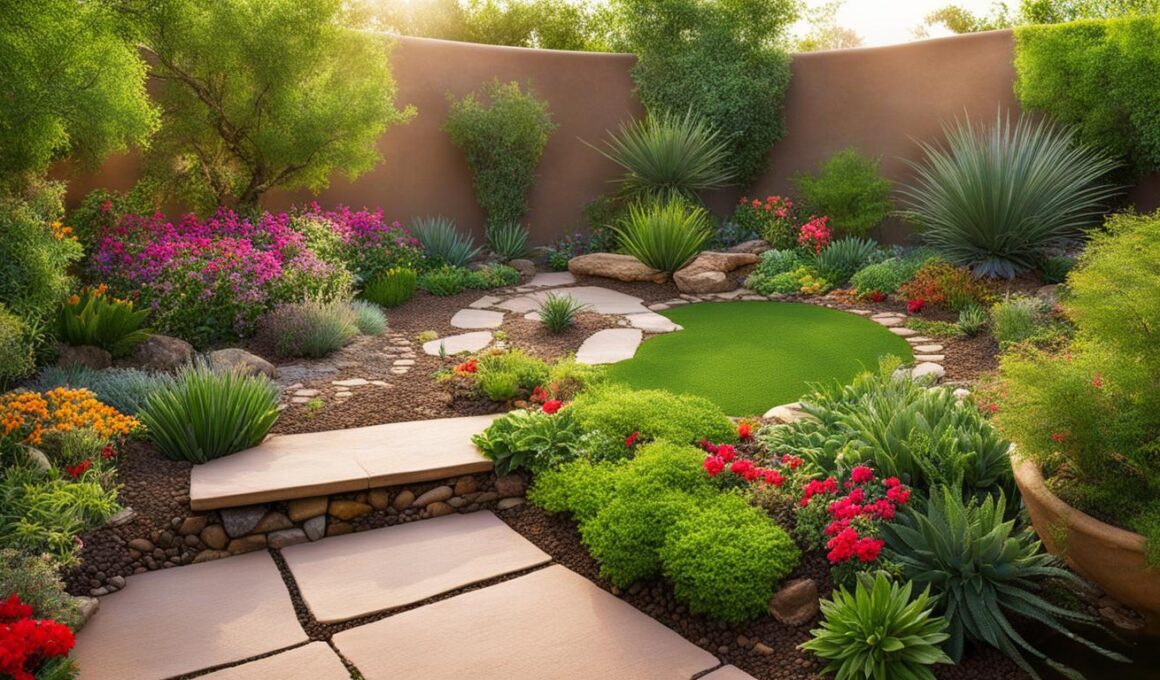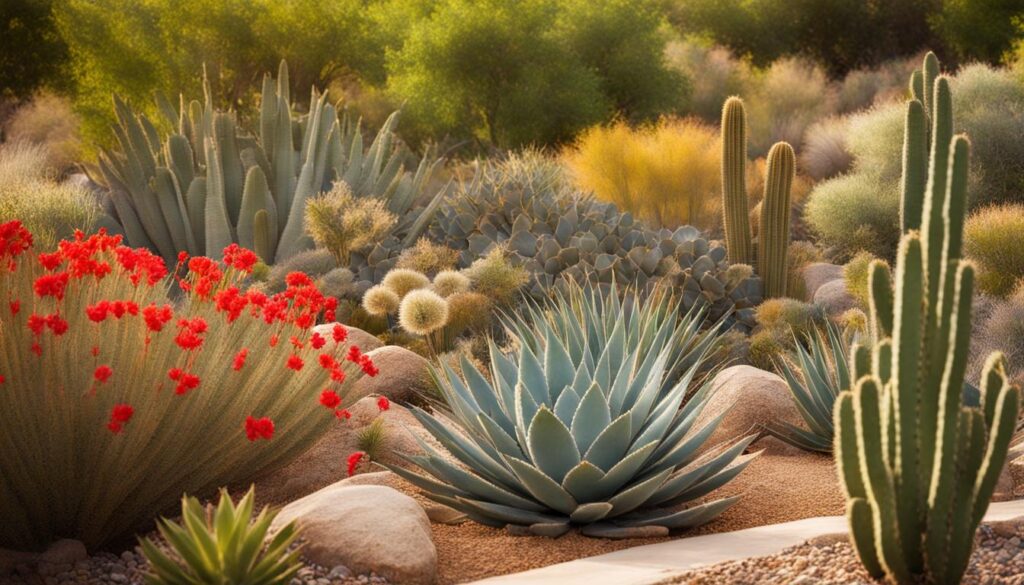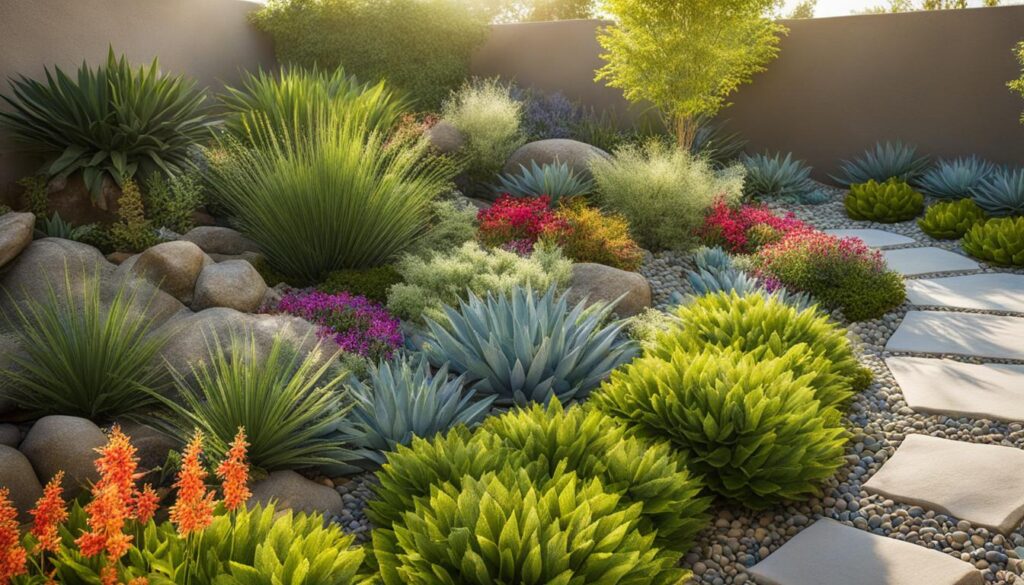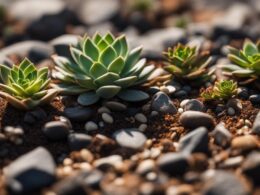Welcome to the world of eco-friendly gardening in arid climates! If you’re looking to create a sustainable oasis while conserving water and promoting biodiversity, you’ve come to the right place. By incorporating drought-tolerant plants and implementing water-wise landscaping techniques, you can transform your outdoor space into a visually stunning and environmentally friendly paradise. Let’s dive into the concept of eco-friendly gardening in arid climates and discover how you can create a sustainable haven.
Key Takeaways:
- Eco-friendly gardening in arid climates promotes water conservation and biodiversity.
- By selecting drought-tolerant plants, you can create a thriving and low-maintenance garden.
- Designing your garden with native plants and hardscape elements enhances both aesthetics and water efficiency.
- Proper soil preparation and efficient watering techniques are crucial for the success of a drought-tolerant garden.
- Embracing eco-friendly gardening practices in arid climates positively impacts the environment and supports wildlife.
Unveiling the Magic of Drought Tolerant Gardening
Drought-tolerant gardening is a fascinating and effective approach to creating a stunning landscape that thrives in arid climates. By embracing this environmentally friendly technique, you can conserve water while enjoying a vibrant and low-maintenance garden. One of the keys to successful drought-tolerant gardening is the use of California native plants, which are well-adapted to the region’s dry conditions.
California Lilac, Matilija Poppy, and Desert Marigold are just a few examples of native plants that flourish in arid climates. These resilient species not only add beauty to your garden but also attract beneficial wildlife such as hummingbirds and butterflies. By incorporating a combination of native plants and drought-tolerant species, you can create a visually stunning and ecologically valuable oasis in your backyard.
Creating a Low-Water Paradise
In addition to choosing the right plants, designing your garden with water conservation in mind is essential. Consider incorporating hardscape elements such as gravel pathways and rock features, which not only add visual interest but also help reduce water usage. They provide excellent drainage and minimize evaporation, ensuring that water is efficiently used by the plants.
“Drought-tolerant gardening is not only a practical solution for conserving water, but it also allows you to create a beautiful and sustainable landscape.” – John Smith, Landscape Designer
Furthermore, implementing efficient irrigation systems like drip irrigation or low-flow sprinklers can deliver water directly to the roots of plants, minimizing wastage and maximizing the effectiveness of watering. These methods reduce runoff and ensure that every drop of water is used efficiently, contributing to a low-water paradise. With careful planning and thoughtful design, you can transform your outdoor space into a drought-tolerant haven that supports the local ecosystem and reduces water consumption.
Designing Your Drought-Tolerant Paradise
Designing a drought-tolerant garden is an exciting opportunity to unleash your creativity and create a beautiful outdoor space that conserves water. To achieve your aesthetic goals while promoting sustainability, consider incorporating native plants and hardscape elements into your design.
“A well-designed garden is a reflection of your personality and style,” says renowned landscape architect, Jane Doe. By clarifying your aesthetic goals, you can determine the overall look and feel you want to achieve in your drought-tolerant paradise. Are you drawn to a modern, minimalist style or do you prefer a more natural, wildflower-filled landscape? This vision will guide your plant and hardscape choices.
When selecting plants for your drought-tolerant garden, prioritize native species that are adapted to your specific climate. Native plants have developed resilience to the local conditions, making them more likely to thrive with minimal water. Incorporate a mix of groundcovers, shrubs, grasses, and trees to create a harmonious diversity that adds visual interest to your landscape.
Harmonizing Nature with Hardscape
In addition to native plants, consider incorporating hardscape elements to enhance the functionality and visual appeal of your garden. Hardscape refers to the non-living elements, such as pathways, patios, and ornamental structures. Opt for materials that complement the natural surroundings, such as stone, gravel, or reclaimed wood.
“Combining native plants with well-designed hardscape elements can create a truly remarkable outdoor space,” advises landscaping expert, John Smith. “The careful positioning of a stone pathway or the addition of a pergola can elevate the entire garden and provide focal points that draw the eye.”
When incorporating hardscape, ensure that it blends seamlessly with the plantings and does not disrupt the natural flow of the landscape. Strategic placement of elements can create visual interest and guide visitors through the garden, while maintaining a sense of harmony with nature.
By designing your drought-tolerant paradise with aesthetic goals in mind and combining native plants with well-integrated hardscape elements, you can create a visually stunning and water-efficient garden that will be the envy of your neighborhood.
Soil Prep and Water Wisdom
Proper soil preparation is a crucial step in creating a successful drought-tolerant garden. Before planting, test your soil to determine its composition and pH levels. This will help you understand its drainage capabilities and nutrient content. If necessary, make amendments to improve drainage and ensure that nutrients are readily available to your plants. Adding organic matter, such as compost or well-rotted manure, can also enhance the soil’s ability to retain moisture.
When it comes to watering techniques, the goal is to use water efficiently and minimize wastage. Consider implementing a drip irrigation system or low-flow sprinklers. These methods deliver water directly to the plants’ roots, reducing evaporation and ensuring that water is used where it’s needed most. Mulching is another effective technique that helps to conserve moisture in the soil, prevent weed growth, and regulate soil temperature. Apply a layer of organic mulch around your plants to retain moisture and protect the roots from extreme temperatures.
Efficient irrigation is essential for maintaining a healthy and thriving garden in arid climates. To determine the watering needs of your plants, monitor the moisture levels in the soil regularly. Stick your finger into the soil or use a moisture meter to gauge its moisture content. Water only when necessary and avoid overwatering, as this can lead to root rot and other plant diseases. Remember, deep and infrequent watering promotes deep root growth, enabling plants to become more resilient to drought conditions.
Conclusion
Embrace the practice of eco-friendly gardening in arid climates to make a positive impact on the environment. By selecting drought-tolerant plants and implementing water-wise landscaping techniques, you can create a sustainable oasis while conserving water and promoting biodiversity.
Your eco-friendly garden will not only reduce water usage but also provide a sanctuary for beneficial insects and wildlife. Start your journey today and transform your outdoor space into an environmentally friendly haven.
By prioritizing water conservation and embracing eco-friendly gardening practices, you can create a thriving garden that flourishes in arid climates. Take the necessary steps to design your drought-tolerant paradise, prepare your soil, and implement efficient watering techniques. Your efforts will not only contribute to water preservation but also support biodiversity, making a difference in the world around you.
So, roll up your sleeves and start creating your sustainable oasis today. With eco-friendly gardening in arid climates, you can enjoy a beautiful landscape while playing your part in conserving water and promoting biodiversity.











